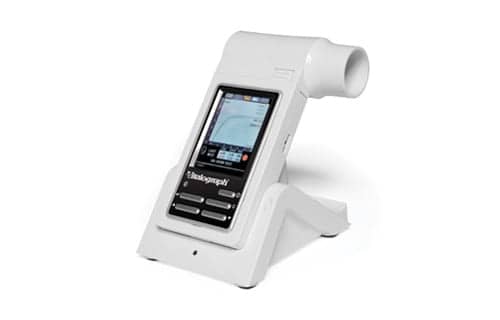A new study, published online in the Annals of the American Thoracic Society, shows that spirometry can offer important insights when diagnosing possible chronic obstructive pulmonary disease (COPD).
Professor Samuel Janes of University College London’s Lungs for Living Research Centre led the study that explored associations between symptoms, the presence of other diseases, spirometry and emphysema in patients enrolled in the Lung Screen Uptake Trial (LSUT). LSUT tested whether specifically targeted invitation strategies could enhance the participation of high-risk, low-income individuals in low-dose CT screening for lung cancer.
“More than half of those attending a ‘lung health check’ as part of a pre-screening assessment were found to have physiological parameters of airflow obstruction consistent with a diagnosis of COPD, while two-thirds did not report a prior diagnosis,” said Janes. “This study highlights that, while the finding of emphysema was fairly common in this population of current or past heavy smokers who were at risk of lung cancer, the physiological changes of airway obstruction found through spirometry was the strongest signal of the presence of respiratory symptoms and thus potentially clinically relevant COPD.”
The study only looked at COPD and did not test the effectiveness of low-dose CT screening for detecting early lung cancer, which has already been proven.
The COPD researchers asked participants about current or recent respiratory symptoms. Those who reported a history of current cough or shortness of breath within the previous 12 months were regarded as having respiratory symptoms. Participants were also asked about a history of COPD, pneumonia, asthma and other potential comorbidities such as coronary heart disease, high blood pressure and diabetes. Participants were labelled as having “undiagnosed COPD” if they met with the standard spirometric definition of COPD and did not report a prior diagnosis of COPD, chronic bronchitis or emphysema.
All participants were given spirometry testing, without being given a bronchodilator in advance. Airflow limitation was classified according to accepted standards. Nine-hundred eighty six participants were divided into three groups, based on spirometry results and their reported history of COPD: “no COPD,” “undiagnosed COPD,” and “known COPD.” Health and demographic variables were statistically analyzed. Participants’ CT scans were read by radiologists specializing in lung disease. COPD was subjectively classified by the radiologists as “none,” “mild,” “moderate” or “severe” based on visual inspection of their CT images.
Thirty-two percent of those with “undiagnosed COPD” had no emphysema on their CT scans. Five-hundred sixty of 986 individuals (57 %) included in the analysis had pre-bronchodilator spirometry consistent with COPD. Sixty-seven percent did not have a prior history of COPD and were considered “undiagnosed.” Emphysema prevalence in those with known COPD was 73 %, while those considered “undiagnosed” had a prevalence of 68 %. Inhaler use and symptoms were more common in the “known” than “unknown” COPD group, while comorbidities were common in all groups. Statistically adjusted odds of respiratory symptoms were more significant for airflow obstruction than emphysema.










